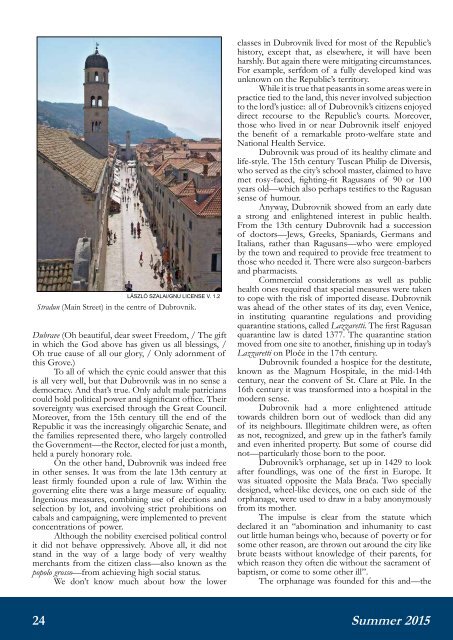CONSERVATIVE
eurocon_12_2015_summer-fall
eurocon_12_2015_summer-fall
- No tags were found...
You also want an ePaper? Increase the reach of your titles
YUMPU automatically turns print PDFs into web optimized ePapers that Google loves.
LÁSZLÓ SZALAI/GNU LICENSE V. 1.2<br />
Stradun (Main Street) in the centre of Dubrovnik.<br />
Dubrave (Oh beautiful, dear sweet Freedom, / The gift<br />
in which the God above has given us all blessings, /<br />
Oh true cause of all our glory, / Only adornment of<br />
this Grove.)<br />
To all of which the cynic could answer that this<br />
is all very well, but that Dubrovnik was in no sense a<br />
democracy. And that’s true. Only adult male patricians<br />
could hold political power and significant office. Their<br />
sovereignty was exercised through the Great Council.<br />
Moreover, from the 15th century till the end of the<br />
Republic it was the increasingly oligarchic Senate, and<br />
the families represented there, who largely controlled<br />
the Government—the Rector, elected for just a month,<br />
held a purely honorary role.<br />
On the other hand, Dubrovnik was indeed free<br />
in other senses. It was from the late 13th century at<br />
least firmly founded upon a rule of law. Within the<br />
governing elite there was a large measure of equality.<br />
Ingenious measures, combining use of elections and<br />
selection by lot, and involving strict prohibitions on<br />
cabals and campaigning, were implemented to prevent<br />
concentrations of power.<br />
Although the nobility exercised political control<br />
it did not behave oppressively. Above all, it did not<br />
stand in the way of a large body of very wealthy<br />
merchants from the citizen class—also known as the<br />
popolo grosso—from achieving high social status.<br />
We don’t know much about how the lower<br />
classes in Dubrovnik lived for most of the Republic’s<br />
history, except that, as elsewhere, it will have been<br />
harshly. But again there were mitigating circumstances.<br />
For example, serfdom of a fully developed kind was<br />
unknown on the Republic’s territory.<br />
While it is true that peasants in some areas were in<br />
practice tied to the land, this never involved subjection<br />
to the lord’s justice: all of Dubrovnik’s citizens enjoyed<br />
direct recourse to the Republic’s courts. Moreover,<br />
those who lived in or near Dubrovnik itself enjoyed<br />
the benefit of a remarkable proto-welfare state and<br />
National Health Service.<br />
Dubrovnik was proud of its healthy climate and<br />
life-style. The 15th century Tuscan Philip de Diversis,<br />
who served as the city’s school master, claimed to have<br />
met rosy-faced, fighting-fit Ragusans of 90 or 100<br />
years old—which also perhaps testifies to the Ragusan<br />
sense of humour.<br />
Anyway, Dubrovnik showed from an early date<br />
a strong and enlightened interest in public health.<br />
From the 13th century Dubrovnik had a succession<br />
of doctors—Jews, Greeks, Spaniards, Germans and<br />
Italians, rather than Ragusans—who were employed<br />
by the town and required to provide free treatment to<br />
those who needed it. There were also surgeon-barbers<br />
and pharmacists.<br />
Commercial considerations as well as public<br />
health ones required that special measures were taken<br />
to cope with the risk of imported disease. Dubrovnik<br />
was ahead of the other states of its day, even Venice,<br />
in instituting quarantine regulations and providing<br />
quarantine stations, called Lazzaretti. The first Ragusan<br />
quarantine law is dated 1377. The quarantine station<br />
moved from one site to another, finishing up in today’s<br />
Lazzaretti on Ploče in the 17th century.<br />
Dubrovnik founded a hospice for the destitute,<br />
known as the Magnum Hospitale, in the mid-14th<br />
century, near the convent of St. Clare at Pile. In the<br />
16th century it was transformed into a hospital in the<br />
modern sense.<br />
Dubrovnik had a more enlightened attitude<br />
towards children born out of wedlock than did any<br />
of its neighbours. Illegitimate children were, as often<br />
as not, recognized, and grew up in the father’s family<br />
and even inherited property. But some of course did<br />
not—particularly those born to the poor.<br />
Dubrovnik’s orphanage, set up in 1429 to look<br />
after foundlings, was one of the first in Europe. It<br />
was situated opposite the Mala Braća. Two specially<br />
designed, wheel-like devices, one on each side of the<br />
orphanage, were used to draw in a baby anonymously<br />
from its mother.<br />
The impulse is clear from the statute which<br />
declared it an “abomination and inhumanity to cast<br />
out little human beings who, because of poverty or for<br />
some other reason, are thrown out around the city like<br />
brute beasts without knowledge of their parents, for<br />
which reason they often die without the sacrament of<br />
baptism, or come to some other ill”.<br />
The orphanage was founded for this and—the<br />
24<br />
Summer 2015


